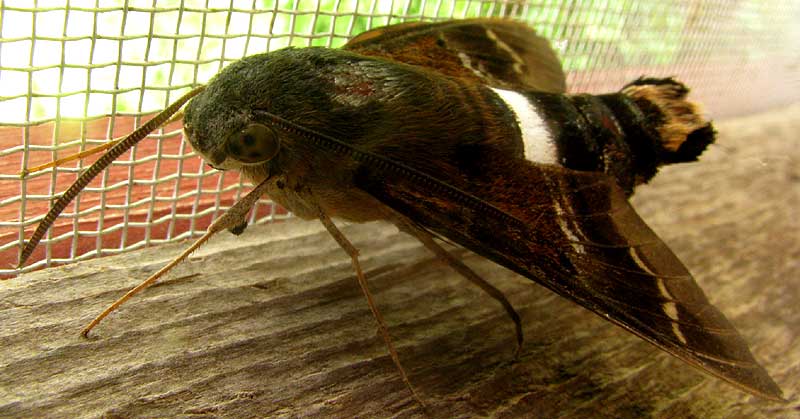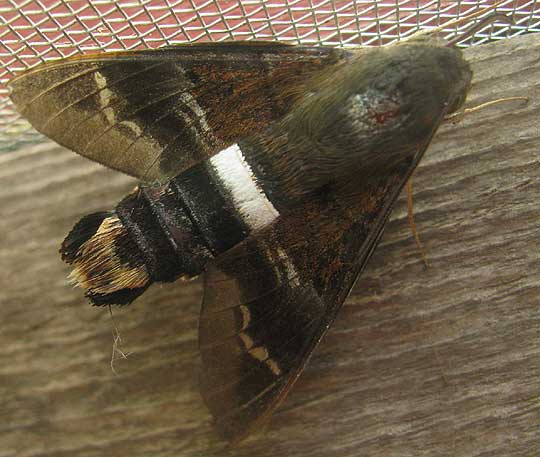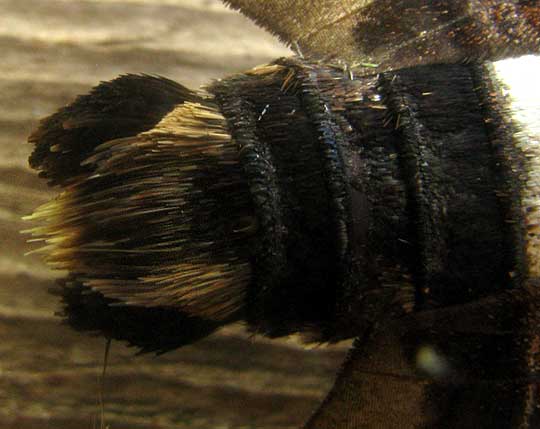Excerpts from Jim Conrad's
Naturalist Newsletter

from the June 22, 2014 Newsletter issued from the valley of the Dry Frio River in northern Uvalde County, southwestern Texas, on the southern border of the Edwards Plateau; elevation ~1750m (~5750 ft); N29.62°, W99.86°; USA
TITAN SPHINX MOTH
Inside the screened-in veranda of the house I'm painting in the valley, a moth had entered where the doors had been removed and couldn't get out. Up close in early morning it looked like a tiny super-aerodynamic, delta-winged fighter jet resting on the tarmac between sorties, as you can see above.
Though no mouth parts are apparent, the moth does possess a long, straw-like proboscis coiled below his head, used for sucking nectar from flowers. A picture more clearly displaying the conspicuous white band on the moth's abdomen appears below:

This moth's thick body and large size -- this kind of moth often is confused with hummingbirds when visiting garden flowers at dusk -- plus its general shape, all suggest that he's a member of the Sphinx Moth Family, the Sphingidae, of which about 124 species are described for America north of Mexico.
With such distinctive markings volunteer identifier Bea in Ontario had little trouble deciding that our moth is the Titan Sphinx, also called the White-banded Day Sphinx, AELLOPOS TITAN, mostly found in the tropics from Uruguay and northern Argentina north through Central America, Mexico and the Caribbean, into the US, where it's established in the Florida Keys and the southernmost US states. Also, sometimes in late summer it ranges north as far as Maine and North Dakota.
Titan Sphinx caterpillars are large, juicy-looking hornworms that feed on members of the Madder Family, the Rubiaceae, of which here the most common species is the Buttonbush abundantly growing in and beside the little Dry Frio River.
A striking feature of our Titan Sphinx is the two-toned tuft of stiff hairs at its rear end, a close-up of which is shown below:

These hairs are known collectively as the hair-pencil, and they can be spread to provide more surface area to the air, for releasing pheromones, or sexual hormones, released from the moth's rear end. Both male and female Titan Sphinxes have them.
Not all moths bear hair-pencils but the males of species that do may use their hair-pencils to sprinkle pheromones right onto the female's antennae. This appears to have such an overwhelming effect on the female that not only is she roused sexually but also she becomes incapable of flying away. In certain lepidopterous species the pheromones thus sprinkled also keep other males away.
Bea submitted our pictures to ButterfliesAndMoths.Org where it's always gratifying to see our IDs confirmed, and our information made available to the rest of the world. You might enjoy seeing that website's page featuring our pictures at https://www.butterfliesandmoths.org/sighting_details/979373.
On that page the species name Aellopos titan is linked to another page providing basic life-history information about Titan Sphinxes and, toward the page's bottom, a map showing where confirmed sightings have originated. If you click on the westernmost large, orange dot in Texas you can see that that's our report. How about that?